Fitting a mortise lock
Fitting a mortise lock is quite straightforward but does need accurate measurements to ensure everything fits correctly.
A mortise lock will normally specify the thickness of door it is designed to fit, problems will only normally arise if an attempt is made to fit a lock to a too thin a door.
It may be necessary to reverse the latch on the lock so that the curved part of the latch strikes the door frame first when the door is closed. See here for how to reverse the latch on mortise locks.
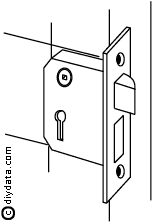 Start by deciding on the height of the mortise lock; if in doubt, check the height of other locks in the property as ideally all the door handles should be the same height from the floor.
Start by deciding on the height of the mortise lock; if in doubt, check the height of other locks in the property as ideally all the door handles should be the same height from the floor.
Position the mortise lock body against the side of the door and mark the top and bottom against the side of the door.
Also mark the positions of the keyhole and handle spindle by marking through the body of the mortise lock - make an allowance for the front plate of the lock as this will be recessed into the edge of the door.
Drill the holes for the spindle and keyhole - make the spindle hole at least as big as the spindle boss of the lock - for the keyhole, drill the top hole and cut out the shape using a thin pad saw.
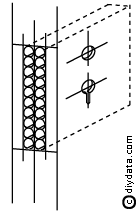 Transfer the positions of the top and bottom of the mortise lock body to the edge of the door.
Transfer the positions of the top and bottom of the mortise lock body to the edge of the door.
Mark the centre line of the door thickness and mark out the width of the mortise lock body equally about the centre line. Use a sharp chisel along the marked lines to establish the edges - this should stop any surface wood from lifting beyond the lines required.
Use the marks on the edge of the door as guides to drill a series of holes into the edge of the door to create the hole to take the body of the mortise lock. Make sure that each hole is at least as deep as the body and front plate of the lock. Pay special attention to keeping the drill parallel with the sides of the door otherwise the mortise lock may not fit squarely, and possibly the drill bit may break through the side panel of the door.
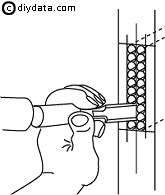 Once all the holes have been drilled, use a sharp chisel to remove the waste wood and roughly smooth the sides of the hole.
Once all the holes have been drilled, use a sharp chisel to remove the waste wood and roughly smooth the sides of the hole.
Once the hole is large enough, check the fit of the lock - the fit should be a clearance fit without too much slack. Make sure that the body fits into the door straight - so that the front plate of the lock fits squarely against the edge of the door, and the sides of the front plate are parallel with the sides of the door.
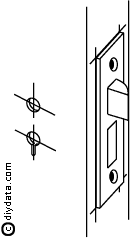 Once the locks fits the hole, put the lock in place and mark around the front plate onto the edge of the door.
Once the locks fits the hole, put the lock in place and mark around the front plate onto the edge of the door.
Remove the lock and use a sharp chisel to mark along the lines to establish the edges - this should stop any surface wood from lifting beyond the lines required. Using a sharp chisel, cut out the rectangular recess on the edge of the door to take the front plate of the lock.
Fit the lock and check the positions of the door handle spindle and key hole - adjust these if necessary.
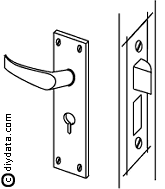 Fit the lock into the door and secure using screws.
Fit the lock into the door and secure using screws.
Fit the door handle spindle and fit the door handles - the one shown here includes the key hole cover, however some door handles and keyhole covers are separate pieces of door furniture.
Before the door handle is fixed to the second side of the door, check the length of spindle, it may need to be shortened so that both handles fit flat onto the door.
Bear in mind that the screws securing the handles to each side of the door will probably line up, so use screws less than half the thickness of the door.
If fitting separate handles and key plates are being fitted, bear in mind that the depth of wood is reduced due to the position of the body of the lock in the door, so use appropriate short screws.
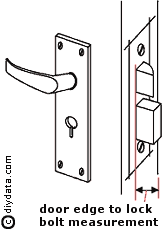 Turn the lock into the locked position and close the door on to the door frame.
Turn the lock into the locked position and close the door on to the door frame.
Mark the top and bottom of the door catch and the lock bolt onto the door frame.
Open the door and transfer these marks to the inside face of the door frame.
On the edge of the door, measure and note the distance from the closing face of the door (i.e. the side which goes against the door stop around the door frame) and the outside of the bolt of the mortise lock.
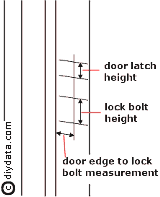 Use the door edge to lock bolt measurement previously noted to mark the distance from the door stop on the door frame .
Use the door edge to lock bolt measurement previously noted to mark the distance from the door stop on the door frame .
Position the striker plate so that the marks made on the door frame line up vertically with the holes in the striker plate - the holes are normally larger that the actual catch/lock bolt, so equalise the difference above and below the marks.
Mark around the striker plate, and also the holes in the striker plate for the the door catch and lock bolt onto the door frame. Marking the position of the sticker plate needs to be accurate to ensure that the door closes tightly.
 Use a chisel to cut out the holes in the door frame to take the door catch and lock bolt - check the measurement of them on the door to establish the depth required in the door frame - remember that there will be a gap around the door when it is closed.
Use a chisel to cut out the holes in the door frame to take the door catch and lock bolt - check the measurement of them on the door to establish the depth required in the door frame - remember that there will be a gap around the door when it is closed.
Use a chisel to cut out a recess in the door frame to take the sticker plate for the mortise lock.
When finished, position and screw the striker plate to the door frame.
